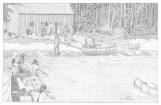1
CHAMPLAIN AND NEW FRANCESamuel de Champlain landed near St. Éloi Island in 1609. At the time, Amerindians, most probably members of the Algonquian nation, occupied the entire coast of the island. According to legend, Champlain named the site in honor of the local tribe's chief : Pat Askam, which was transformed to Batiscan. St. Éloi Island became a rather busy trading post where explorers and Amerindians would meet.
2
Samuel de Champlain at St. Éloi Island17th century, circa 1609
Batiscan (Quebec), Canada
 Credits:
Credits:Brian O'Keefe
4
The high autochthone population density drew the attention of missionaries. The Jesuits acquired the seigniory of Batiscan on March 13th, 1639. By this deed of transfer, signed by Father Jacques de la Ferté, ordinary chaplain and counsellor to King Louis XIII, France hoped to establish the catholic religion in New France. And the Society of Jesus deployed a great deal of efforts in doing so. The Jesuits erected, among other things, a mission to facilitate the conversion of the ''savages'' to the catholic religion.
5
Despite their great efforts, the First Nation's people abandoned the area. The Jesuits could only realize that their mission was a failure. They also left Batiscan in 1666, but remained the owners of the seigniory.
From this time on, the seigniory was divided and lands were granted to settlers wishing to establish themselves in the region. The settlers had been pressuring the authorities for some years in order to acquire properties in this region of fertile lands. Even in their absence, the Jesuits executed their seigniorial duties. They had a village mill built a short time after they left, around 1671. At that time, the mill was of great importance since it supplied dozens of households with the flour needed to bake bread, a staple food.
6
Windmill at Pointe St. Éloi17th century, circa 1671
St. Éloi Island, Batiscan (Quebec), Canada
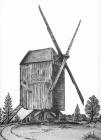 Credits:
Credits:Drawing by Berthe - I. Brunelle of Batiscan
7
THE ST. FRANÇOIS-XAVIER DE BATISCAN PARISHIn 1669, many settlers had already established themselves in the vicinity of the St. Lawrence River. The population grew rapidly and, in 1674, a chapel was erected near the mill. It could not be called a church since the parish had not yet been officially founded and it was but a plank cabin. Before the construction of the chapel, masses and religious ceremonies were held at the house of Nicolas Rivard, the chief of the local militia.
8
First chapel of Batiscan17th century, circa 1674
Batiscan (Quebec), Canada
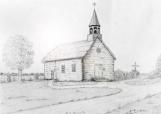 Credits:
Credits:Drawing by Berthe - I. Brunelle of Batiscan
9
The canonical erection of the St. François-Xavier de Batiscan parish was celebrated on November 2nd, 1684, by Monseigneur François Montmorency de Laval. The parish was placed under the patronage of St. François-Xavier, co-founder of the Jesuits. By that time, the parish already counted 300 souls.
The presbytery itself was built facing the St. Lawrence River in 1696. The house was of Normand style and well suited to the climate of the region. The humble house had only five rooms: a living room, a den, two bedrooms and an attic, used as a storage space.
10
First presbytery of Batiscan17th century, circa 1696
Batiscan (Quebec), Canada
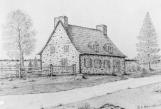 Credits:
Credits:Drawing by Berthe - I. Brunelle of Batiscan
11
A church made of stone soon replaced the rudimentary chapel. Built in 1708, it was erected near the presbytery, on the west side, not on the site of the first chapel. Perhaps the proximity of the St. Lawrence influenced the selection of the new site. The building was constructed parallel to the river and the front of the church faced the village of Champlain.
The church measured approximately 32 feet wide by 65 feet long. At the front, the stone wall was pierced by a large door. There was also a secondary entry near the south side. Eight windows provided daylight to the church and another to the vestry. The church was topped by a roof made of shingles.
12
First church of Batiscan18th century, circa 1708
Batiscan (Quebec), Canada
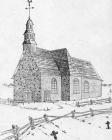 Credits:
Credits:Drawing by Berthe - I. Brunelle of Batiscan
13
At the beginning of the 19th century, the ill-maintained first presbytery crumbled under the weight of time. Estimated refection costs were deemed too high by the parishioners who ultimately decided to tear down the presbytery and build a new one on top of the old foundations. So that the building would endure, 32-inch thick walls were built of stone. Since fieldstones were not easily found in Batiscan, these were brought in from St. Pierre-les-Becquets, located on the south shore of the St. Lawrence. The stones were carried from one shore to the other over the winter, when the river was frozen. The ice bridge, guarded by the shore master, facilitated the crossing of the loads.
14
Second presbytery of Batiscan20th century, before 1922
Batiscan (Quebec), Canada
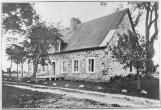 Credits:
Credits:Vieux manoirs, vieilles maisons, Commission des monuments historiques de la province de Québec
